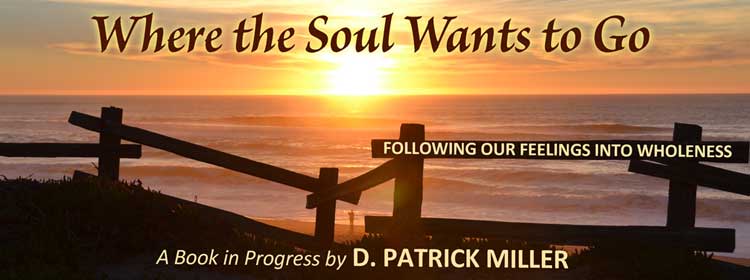
Funding Goal: $5,000
Accepting contributions now!
See Current Status _______________________Support
Opportunities$25.00
I want to be a part of this!
List me as a contributing Supporter online and in the finished book, and add me to the Fearless Books mailing list to receive all progress announcements. Also, please send me an advance signed copy of WHERE THE SOUL WANTS TO GO as soon as it’s available._______________________
$50.00
I want to know
how it’s going.
In addition to the perks above, add me to the private mailing list for advance excerpts from WHERE THE SOUL WANTS TO GO, so I can offer comments and suggestions for the work in progress._______________________
$100.00
I will definitely want to
spread the word.
In addition to all the perks above, send me FIVE advance copies as soon as they’re available._______________________
$250.00
I want a reminder on my wall.
List me as a Supporter, send me one advance signed copy AND advance excerpts AND a 16"x24"print from the author's "Sunset Fence" series...
OR
(Printing and framing options available)_______________________
$500.00
_______________________
I want to get my soul going...
List me as a Supporter, send me 1 advance copy of WHERE THE SOUL WANTS TO GO and advance excerpts, AND sign me up for a Wisdom Resources class or coaching with D. Patrick Miller. (Alternate for Writers: Get a full manuscript assessment from Fearless Literary Services, a $1295 value, for $995.00. Pay $500 now and the balance of $495 on delivery of assessment.)FUNDING POLICIES:
Please note that all contributions to this campaign constitute advance purchases of books and special services from Fearless Books, and are non-refundable and non-deductible. Coaching sessions or publishing consultations can be arranged soon after a contribution is made.Dear Fearless Reader:
Since the beginning of my career as a magazine journalist and book author over 30 years ago, I have reported on the profound changes brought to our culture by the growing "spiritual but not religious" phenomenon. And I've often questioned what it really means to be "spiritual" — not just in terms of what we believe, but more importantly, how we feel and behave.
These are the questions at the heart of my new book in progress, WHERE THE SOUL WANTS TO GO: Following Our Feelings into Wholeness. The ideas in this book have been in development for about 15 years, and include my original formulation of "Seven Directions of Wholeness" that map the spiritual journey in a way that hasn't been done before.
I'm now writing a proposal for this project, which will be presented to major publishers in the field. At this unfunded, time-consuming stage, I'm seeking reader involvement in two forms: financial contributions and feedback on the writing in progress. For a $50 contribution or more, you will be added to a private mailing list to receive excerpts of the book in progress (including the entire first chapter, excerpted below), and I will welcome your comments and suggestions.
Every level of contribution includes a signed advance copy of the book as soon as it's available. Higher levels include original photo prints and Wisdom Resources classes or coaching.
This is the third book of my own that I've partially crowd-funded. I always appreciate not just the financial assistance, but also the reader community created by "putting the word out" in a way that just wasn't possible in a pre-Internet era. Writing is largely achieved in solitude, but it's always enriched by a creative support community. Thanks for taking a sneak peek at my new work in progress and helping me find its full potential.
________________________
EXCERPT FROM CHAPTER 1 OF
WHERE THE SOUL WANTS TO GOBeing religious has always been pretty well-defined: Religious people go to a church, temple, or mosque regularly, and they believe in the tenets and commandments of their chosen religion. And they openly identify themselves as Christian, Jewish, Buddhist, or Islamic, and so on.
Being only “spiritual,” however, is much more difficult to define, and its meaning can vary greatly from person to person. Are you spiritual if you do yoga and meditate? Are you spiritual if you just read a lot of spiritual books? Or are you spiritual if you take a lot of long walks in nature? The answer could be “yes” to all three — and there are many other behaviors that could be identified as spiritual, including some that are thought of as traditionally religious.
But the essence of spirituality is the awareness and conscious development of one’s inner life — or what might be called the advancement of the soul, for lack of a better term. Without getting into theological hairsplitting, I define “soul” as the learning part of ourselves: a mixture of our ego-driven, defensive self-absorption and selfless Spirit, or “higher consciousness.” Thus I would say that our soul struggles, but our spirit does not. It’s the soul that reflects on the whole of our mixed being, that yearns for a deep and lasting happiness, and that can make deliberate and difficult changes along the way toward that goal.
If we’re advancing on a spiritual path, it’s worth asking where we’re going exactly, and what changes we may find ourselves going through along the way. Based on decades of study and experience with my own spiritual path, I’ve devised a kind of “soul map” that I call the The Directions of Wholeness.
© COPYRIGHT 2016 D. PATRICK MILLERIf you look first at the center column entitled Soul, you can read seven kinds of experience that are universal in human experience: Suffering, Anger, Blame or Guilt, Questioning, Conditional Love, Sorrow or Happiness, and Community. These qualities characterize "the world" as we know it; we feel and express them on a regular basis.
In the left column you’ll find the immature qualities of the Ego, all of which we have probably experienced more than we would like: Despair, Rage, Condemnation, Apathy, Defensiveness, Bitterness, and Self-Absorption. The more time we spend in such states, the more it will seem that life on earth is little more than a living hell.
Finally, the right column lists the ideal potentials of Spirit: Transcendence, Responsibility, Forgiveness, Purpose, Perfect Love, Joy, and the ultimate experience of God. These spiritual potentials are seldom fully realized in our lives for any length of time, but that doesn’t mean they are unreachable. They will all be experienced with increasing frequency as we progress toward wholeness, though we are unlikely ever to leave all the conditions of ego behind. Each time we do realize one or more spiritual qualities in our lives ─ even if only for a moment ─ we know what "heaven" feels like. And we can experience any or all of the spiritual ideals with or without a formal religion.
Before we consider an overview of the seven spiritual progressions, a couple of important points need to be made. First, it’s crucial not to regard any of the apparently negative qualities in this table as permanent flaws or "sins." While there is a good reason for the traditional notion of sinfulness ─ that is, the need to recognize our immaturity and incompleteness, as well as the damage we can do in the thrall of egotism ─ we can actually make things worse by assuming that our flaws are permanent and cannot be undone. It’s very easy to become so convinced of our "fallen nature" that we turn cynical or hopeless, and give up trying to grow or change. Worse yet, we may assume that the changing we need to do will be taken care of by God, in exchange for a confession or a contribution to the collection plate. This attitude is the source of much religious hypocrisy.
Nor should we judge egotism itself as a low or evil condition. We are all born as limited, physical beings who feel the need to defend ourselves, and we naturally fear surrender in all its forms. Growing up psychologically requires the development of a so-called "healthy ego" (which I would call "a soul making progress"). It has often been observed that one must have a definite sense of self before it can be authentically surrendered on the spiritual path. In other words, you’ve got to have an ego — and be aware of its tricks, delusions, and manipulations — before you can give it up.
The seven progressions of ego, soul, and spirit qualities I’ve chosen to discuss are certainly not meant to summarize all of human character, nor should they limit your own view of your spiritual experience. But you may find this chart useful as a model to figure out your own progressions of spiritual growth, adding to and revising them over time.
While we might measure one's religiosity by the fervency of beliefs, we know our spiritual life primarily through our feelings. When you find yourself temporarily wrapped up in any painful or negative feelings, it can be extraordinarily helpful to have a reminder that there is somewhere else to go ─ that your path is still underfoot and leading you forward even if you feel mired in emotional quicksand.
What follows is a brief overview of the seven Directions of Wholeness. In the chapters to follow, I'll examine each one in more detail, with specific suggestions and exercises for growth.
Despair › Suffering › Transcendence
In his first Noble Truth, the Buddha asserted that "life is suffering." This fundamental precept is an acknowledgement of the inescapable difficulties that life on earth presents to all of us. In the context of Buddhist teaching, this principle also acknowledges the basic impetus that all of us have toward spiritual development: to master the experience of suffering that we inevitably encounter in the course of life. A huge step forward in spiritual maturity is the realization that while we cannot prevent suffering in all its forms, we can learn to respond to it in a way that lessens its impact on ourselves and others. In a nutshell, we can learn not to suffer over our suffering. This is the beginning of transcendence.
Despair is an extreme state of suffering in which the ego’s sense of loneliness and impotence is most reinforced, convincing us that we are fundamentally alone and suffering more than anyone else ever has, or could even imagine. It’s the state in which people commit suicide because they see no way out of their current predicament, or they dread even worse times ahead. "Clinical depression" is the standard diagnosis of chronic despair, and recent statistics indicate that it is a surprisingly common condition.
Bearing our suffering well is one of the chief tasks of soulfulness. As we grow beyond the egocentric perception that our personal suffering is uniquely immense, we are better able to develop a compassionate understanding of the suffering that’s inherent to the human condition. We become less and less likely to project our pain or "take it out" on others, and less obsessed with ending our pains at any cost.
The root of the word transcendence means "to climb over," but the laborious part of transcendence is often forgotten by those who use the word lightly. Seldom will we be able to simply float away from our suffering, but we can learn to rise above it. From the transcendent point of view, the only healing that matters is healing that contributes to the well-being of others. Or as A Course in Miracles suggests, "When I am healed I am not healed alone." [Workbook Lesson 137]
This is not as distant an ideal as it may sound at first. Many therapists are "wounded healers" who have followed the path of private suffering and recovery into helping others with similar afflictions. The pain that initially isolates us can become the bridge we cross to a life of transcendent service....
To read the rest of this chapter and receive more excerpts of the book in progress, become a supporter of this book at the $50 level or higher...
C L I C K T O :
Books • Literary Services • Wisdom Resources • Fearless Fine Arts




